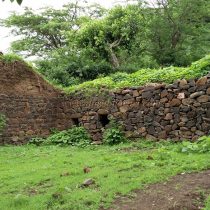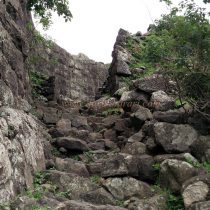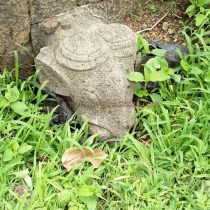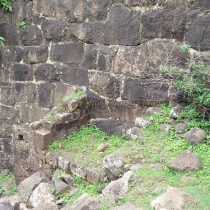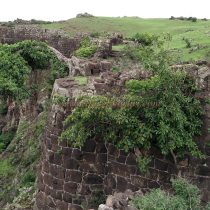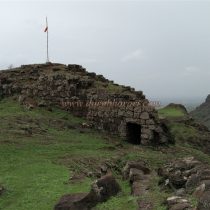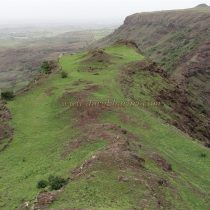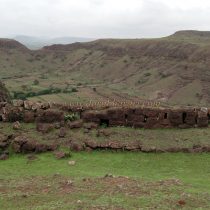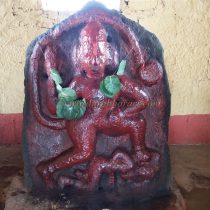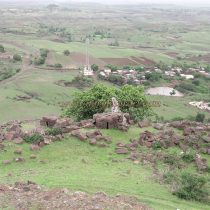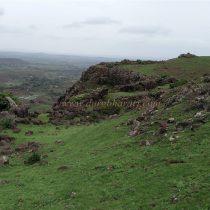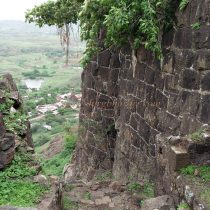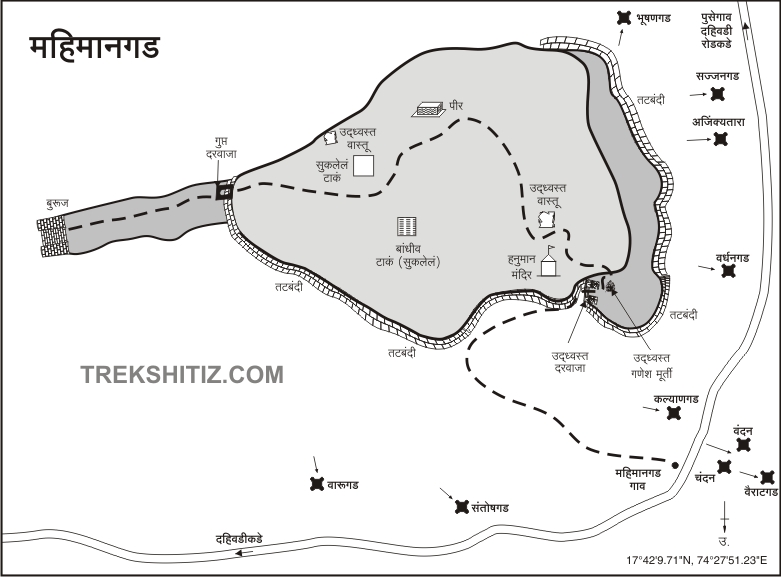MAHIMANGAD
TYPE : HILL FORT
DISTRICT : SATARA
HEIGHT : 3155 FEET
GRADE : EASY
Due to the low rainfall in the eastern part of Satara district, this part is considered a drought-prone region. In this area, instead of continuous mountain ranges, a large number of hills are seen on a flat plateau. Mahimangad is a fort built on a small hill in Maan taluka of Mandesh. Although low in height, the fort was built to keep an eye on the plateau. The way to the fort is through Mahimangad village. Both Mahimangad village and Ukirde village are accessible from Mahimangad. The road from Ukirde village is not the original road but it goes through the broken ramparts to the fort. This road is worn out and inconvenient as it is not used much. From Mahimangad settlement, however, the path is long and it takes more time to reach the fort. We reach Mahimangad village in twenty minutes from Mahimangad fork.
...
Ukirde village is at the southern foothills of Mahimangad fort. Mahimangad settlement is situated on the northern foothills. A footpath leads to the fort from the temple in front of the Zilla Parishad office of Mahimangad village. Next to the temple, you can see the remains of an old mansion. There is a bastion next to the door, but you can't see it until you get closer. As you ascend this path, three water cisterns are carved in the rock below the ramparts on the left. One of them is covered with thick bushes and the other is full of silt but the third has potable water. Seeing the cistern, we come back to the main path of the fort. At the end of the road, there are some steps. It takes half an hour to reach the fort by this route. The ramparts around the gates are still in good condition and a tree on the left rampart has grown horizontally outside the ramparts. The east-facing gate of the fort is mostly destroyed today and only the stone frame remains. Elephant heads are carved on both sides of this stone frame pillar. The lower part of the outer door has been buried to some extent in the soil and the stone carvings have been dug out to make these sculptures visible. The door is protected by a winding path in front of the door and a bastion at the mouth. To hide mail door style construction is considered to be a feature of Shivaji Maharaj’s period. After crossing this door we enter the fort. After entering the fort, the path on the left leads to the top of the fort and the path in front leads to the ramparts. Upon entering the fort, there is a temple of Hanuman on a small hill in front and there is a water cistern next to it. In front of it, you can see the steps made to go to the bastion. From here the entire ramparts of the fort are visible. A little further on the slope, there are large water cisterns carved in the rock and the upper part of this cistern is built of wrought stone. Although there is water in this cistern, it is not drinkable. Next to it is another small dry cistern plated with lime. Near this cistern, a large pit has been created, but water does not accumulate in it due to leakage. At some distance above these cisterns, the ruins of two large structures can be seen. On the east side of this cistern, there is a hill trunk, which is separated from the main fort by building a rampart. A strong watchtower has been built at the tip of the trunk and a small gate has been built in the ramparts to reach the trunk. A few construction remains can be seen on this trunk. When turning back from the trunk, go to the left side of the rampart without going to the main path where the cisterns are. There is a tomb near the ramparts above the cistern. From here, while walking towards the gate from the edge of the ramparts, one can see the ramparts of the fort and its bastions. As the ramparts have collapsed in some places, utmost care is to be taken. From the top of the fort, Bhushangad, Vardhangad forts, Jarandeshwar hill, and Mol Ghat area can be seen. One hour is enough to see the entire fort. After the establishment of Swarajya, this province under the rule of Adilshah along with Mahimangad came under the control of Marathas. Earlier, 75 people were deployed along with Mahar- Ramoshi to protect the fort. The land of the fort's keeper and Sabnis still inherit to their descendants Patil and Kulkarni.
© Suresh Nimbalkar

